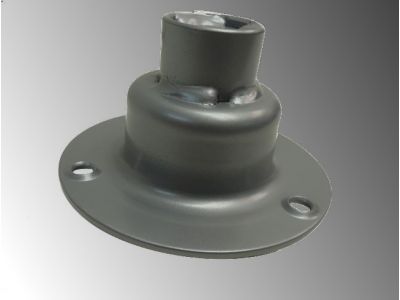What's the Deal with Powder Coating?
Ask Us A Question
Powder Coating dates back to the late 1940s and the early 1950s. When it was in its beginnings the only way to powder coat something was to spray it on with an electrostatic spray gun. Thanks to Dr. Erwin Gemmer, a German scientist, we now have the fluidized bed application for powder coating as well. After that discovery, many different application methods began to emerge, and even today we are finding new ways to use this versatile powder coating. Powder Coating is much stronger than conventional paint and the number of applications where it can be used is growing.
What exactly is Powder Coating?
There are two types: Thermoplastic Powder and Thermoset Polymer. Thermoplastic Powder is generally applied with a fluidized bed process. First, the part is heated to a temperature above the melting point of the powder. Then, the heated part is dipped into a pool of free-flowing powder. As the part is dipped the powder around it melts and forms a smooth homogenous bond coating the surface. It can also be applied with an electrostatic spray process, where the part is heated to a temperature above the melting point of the powder, and then the powder is sprayed onto the heated part. The powder, upon contact, will melt onto the part and form a strong coating.
Thermoset Polymer undergoes a chemical change called cross-linking once it’s cured. At Wright, we use two types of thermoset polymers: Epoxy based resin and Polyester based resins. Epoxy based resins are hard, impact resistant and have excellent corrosion prevention. Although epoxy is extremely strong it is not recommended for use outdoors due to its poor UV resistance. Polyester based resins are just as strong as the epoxy resins; however, it is UV resistant and can be used outdoors. Harsh weather is no match for our polyester coatings.
How does Wright apply Powder Coating?
There are two ways to apply powder coatings, which are by an electrostatic spray gun and by a fluidized bed-dip process. The electrostatic spray can be used with both epoxy and polyester resins, and the part is heated to a temperature that will allow the powder to melt on contact with it and form a smooth bond. The powder is sprayed onto the heated part and upon contact it melts and solidifies. The fluidized bed-process is best left to an epoxy based coatings. The part is still heated past the melting point of the powder, but instead of presenting the powder to that part, we are presenting the part to the powder, i.e. we dip the heated part into the pool of free-flowing powder. As the part is being dipped the powder around it melts onto the part and forms that homogenous bond. After the parts are coated they go through a curing process which allows the powder to set.
Powder coating is environmentally friendly; any overspray of the powder that does not attach to the part can be collected and used again. Powder Coating has many applications that it can be used for, and is growing in popularity every year. Compared to traditional paint we can get a stronger and longer lasting coating with powder. Our 4 powder coating lines allow us to properly scale each job and get it done Wright.

